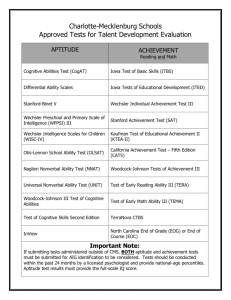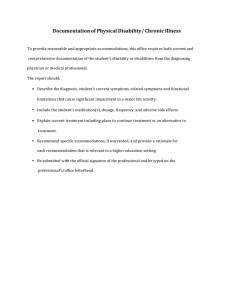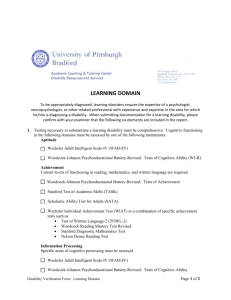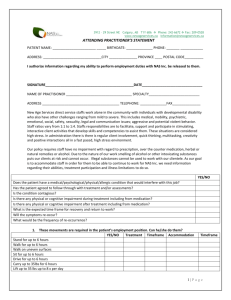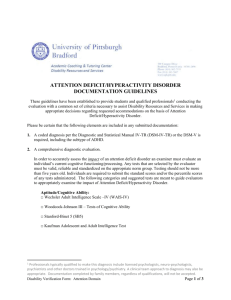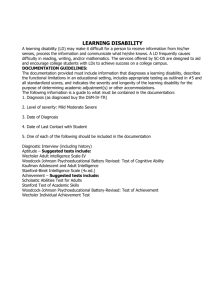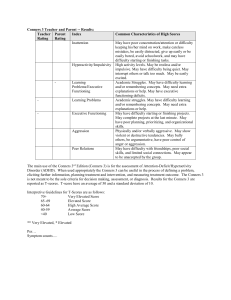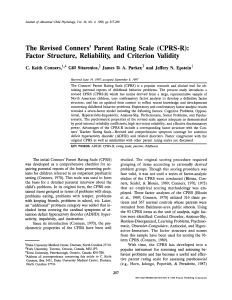Guidelines for Documentation of Attention Deficit
advertisement
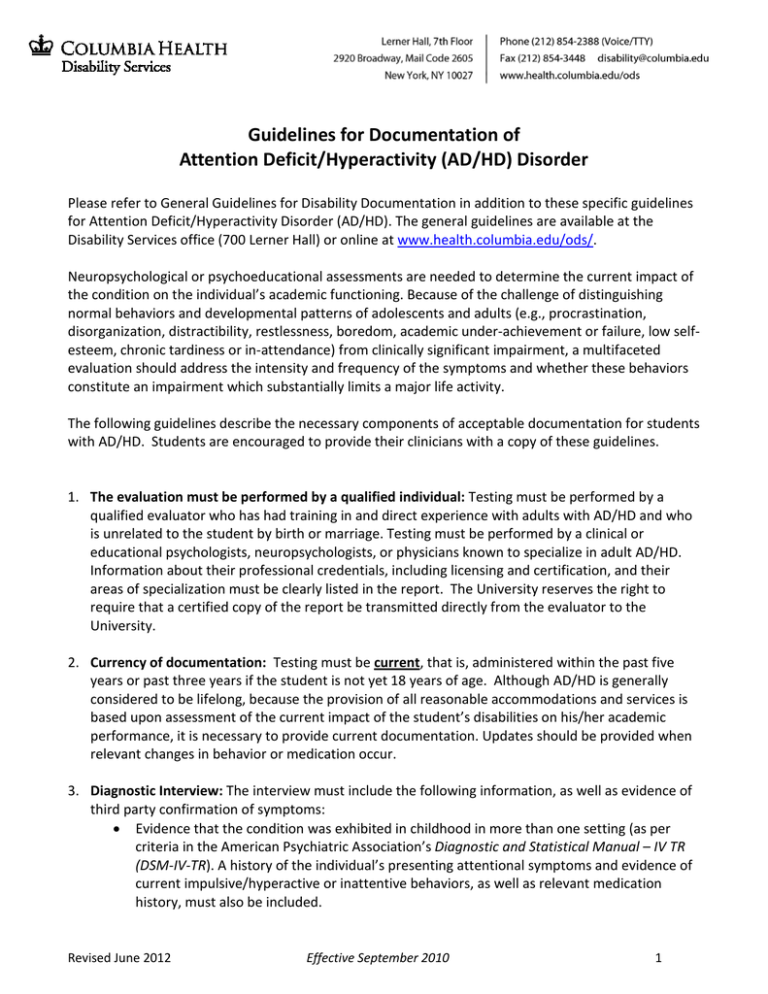
Guidelines for Documentation of Attention Deficit/Hyperactivity (AD/HD) Disorder Please refer to General Guidelines for Disability Documentation in addition to these specific guidelines for Attention Deficit/Hyperactivity Disorder (AD/HD). The general guidelines are available at the Disability Services office (700 Lerner Hall) or online at www.health.columbia.edu/ods/. Neuropsychological or psychoeducational assessments are needed to determine the current impact of the condition on the individual’s academic functioning. Because of the challenge of distinguishing normal behaviors and developmental patterns of adolescents and adults (e.g., procrastination, disorganization, distractibility, restlessness, boredom, academic under-achievement or failure, low selfesteem, chronic tardiness or in-attendance) from clinically significant impairment, a multifaceted evaluation should address the intensity and frequency of the symptoms and whether these behaviors constitute an impairment which substantially limits a major life activity. The following guidelines describe the necessary components of acceptable documentation for students with AD/HD. Students are encouraged to provide their clinicians with a copy of these guidelines. 1. The evaluation must be performed by a qualified individual: Testing must be performed by a qualified evaluator who has had training in and direct experience with adults with AD/HD and who is unrelated to the student by birth or marriage. Testing must be performed by a clinical or educational psychologists, neuropsychologists, or physicians known to specialize in adult AD/HD. Information about their professional credentials, including licensing and certification, and their areas of specialization must be clearly listed in the report. The University reserves the right to require that a certified copy of the report be transmitted directly from the evaluator to the University. 2. Currency of documentation: Testing must be current, that is, administered within the past five years or past three years if the student is not yet 18 years of age. Although AD/HD is generally considered to be lifelong, because the provision of all reasonable accommodations and services is based upon assessment of the current impact of the student’s disabilities on his/her academic performance, it is necessary to provide current documentation. Updates should be provided when relevant changes in behavior or medication occur. 3. Diagnostic Interview: The interview must include the following information, as well as evidence of third party confirmation of symptoms: • Evidence that the condition was exhibited in childhood in more than one setting (as per criteria in the American Psychiatric Association’s Diagnostic and Statistical Manual – IV TR (DSM-IV-TR). A history of the individual’s presenting attentional symptoms and evidence of current impulsive/hyperactive or inattentive behaviors, as well as relevant medication history, must also be included. Revised June 2012 Effective September 2010 1 4. Relevant Testing: • Actual scores from all instruments must be provided with standard scores and percentile rank scores. • The most recent edition of each assessment instrument must be administered. • The report must indicate the norm-reference group. For example, the report must specifically indicate how the student performs in relationship to the average person in the general population. The following areas must be addressed using standardized instruments: Aptitude: The Wechsler Adult Intelligence Scale IV (WAIS-IV) with subtest scores is the preferred instrument. The Woodcock-Johnson III Normative Update Tests of Cognitive Abilities: Tests of Cognitive Ability or the Stanford-Binet Intelligence Scale-IV is acceptable. Brief versions or screening measures are not comprehensive (including the Kaufman Brief Intelligence Test and the Slosson Intelligence Test-Revised) and are not accepted. Please note: The WAIS-III will not be accepted after January 1, 2010. Evaluations occurring after this date must include the WAIS-IV. Achievement: Assessment of comprehensive academic achievement in the areas of reading (decoding and comprehension), mathematics (calculation and problem solving), oral language, and written expression (spelling, punctuation, capitalization, writing samples) is required. The Woodcock-Johnson III Normative Update Tests of Achievement is the preferred instrument. The Scholastic Abilities Test for Adults (SATA) and the Stanford Test of Academic Skills (TASK), Wechsler Individual Achievement Test - III (WIAT-III or specific achievement tests such as) are acceptable. Please note: • The Wide Range Achievement Test 4 (WRAT-4) is NOT a comprehensive measure of achievement and therefore should not be the only measure of overall achievement utilized. • Multiple reading assessments must be provided in order to establish the need for audio/electronic text books as an accommodation or documenting a reading disability. The Nelson-Denny Reading Test (NDRT) form G or H, Gray Oral Reading Test (GORT- 5th Edition), Test of Word Reading Efficiency (TOWRE), and reading subtests of the Woodcock-Johnson Tests of Achievement are acceptable. If the impairment involves reading speed, the NDRT should be administered under both standard time and extended time conditions. Informal measures should be included as well. 2 Cognitive and Information Processing: Specific areas of cognitive and information processing must be assessed. These domains include, but are not limited to: • Attention (e.g., visual and auditory spans of attention, scanning tasks, and vigilance assessment, including continuous performance tasks). Examples of acceptable measures include, but are not limited to Test of Variables of Attention (TOVA) and the Conners Continuous Performance Test - II (CPT-II) • Memory (i.e., visual and verbal acquisition, retrieval, retention, and recognition) • Processing speed and cognitive fluency (e.g., timed psychomotor or graphomotor tasks, decision and naming fluency) • Sensory-perceptual functioning (e.g., high-level visual, auditory, and tactile tasks) • Executive functioning (e.g., planning, organization, prioritization, sequencing, selfmonitoring) Examples of acceptable measures include, but are not limited to BRIEF(accepted for students evaluated prior to age 18), Delis-Kaplan Executive Function System, Stroop Color and Word Test, Trail Making Test Parts A and B, Tower of LondonSecond Edition, Wisconsin Card Sorting Test (WCST). • Motor functioning (e.g., tests of dexterity and handedness) • Visual acuity and possible need for prescription eye glasses. Use of the Woodcock-Johnson Normative Update III Tests of Cognitive Ability (Standard Batterysubtests 1-10) or subtests from the Wechsler Adult Intelligence Scale IV (WAIS-IV) are preferred. California Verbal Learning Test (CVLT-II), Detroit Test of Learning Aptitude -4 (DTLA- accepted for students evaluated prior to age 17), Halstead-Reitan Neuropsychological Test Battery, WAISIV Working Memory Index (WMS), Wide Range Assessment of Memory and Learning - Second Edition (WRAML-2), Wechsler Memory Scales — IV (WMS-IV) are acceptable and should supplement the WJ-III. Rating Scales: Self-rated or interviewer-rated scales for categorizing and quantifying the nature of the impairment are useful in conjunction with other data, and are required. Examples of acceptable measures include, but are not limited to: ADHD Rating Scale IV, Beck Depression Inventory (BAI), Brown Attention-Deficit Disorders Scale, Conners’ Rating Scales-3 (Conners 3), Conners Adult ADHD Rating Scales – Self and observer forms (CAARS), Attention Deficit Disorder Evaluation Scale (ADDES-3): Home and Self Report versions, and the Wender Utah Rating Scale (WURS). 5. Specific diagnosis: This should not merely refer to symptoms but should correspond to a specific diagnosis as per the American Psychiatric Association’s Diagnostic and Statistical Manual – IV TR (DSM-IV-TR). Based on the current predominant features, the appropriate sub-type should accompany the diagnosis. 3 6. Clinical Summary: A narrative clinical summary must include the following: • An indication that other possible causes of the presenting behavior have been ruled out • A statement indicating whether the student was taking medication at the time of the evaluation and how the results were affected • A description of functional limitations and the impact of the condition on the student’s current participation in courses, programs, services, or any other activities of the University • A statement as to what major life activity(ies) is substantially limited by the student’s condition(s) and a rating of the limitation, such as mild, moderate, substantial or severe of each affected major life activity, both with and without the use of mitigating measures, such as treatment and medication • Discussion of the student’s use of medication and its ameliorative effects • Recommendations for academic or other accommodations, including a rationale for each, linked to specific test results. Please also note that a clinical diagnosis of AD/HD or related prescription of medication does not necessarily justify the provision of accommodations. Sufficient documentation must be provided to demonstrate that the student requires specific accommodations in the University setting, despite the use of mitigating measures. Students without a clinical diagnosis of AD/HD who suspect that they are experiencing symptoms of AD/HD should first see a clinician for a formal screening before seeking a full evaluation. Students on the Morningside campus who have paid the University Health Services Fee can make an appointment for such a screening with Counseling and Psychological Services (CPS) at (212) 8542878, or at the 8th floor, Lerner Hall. Students at the CUMC campus can make an appointment for such a screening with a provider at the Mental Health Service by calling (212) 496-8491. Contact DS for further information. 4
